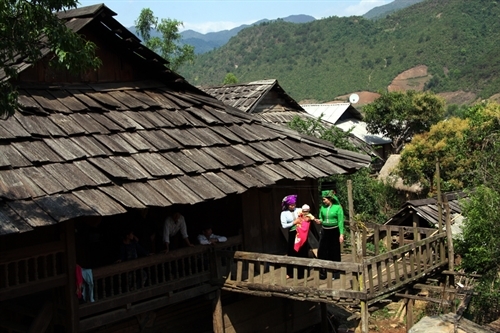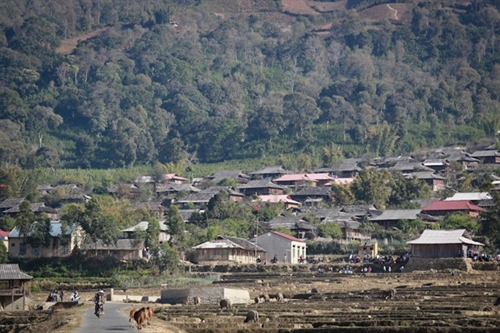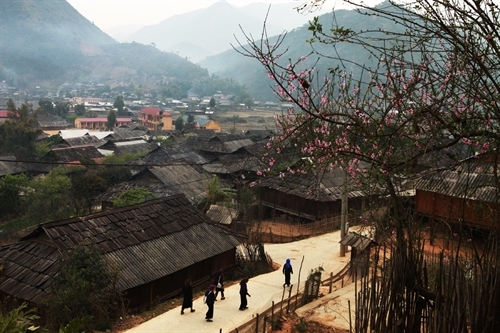 Life & Style
Life & Style

Sơn La Province is about 200km from Hà Nội to the northeast, at an altitude of over 1,800m above sea level. The province is famous for quite a few landscapes such as Mộc Châu Plateau, Dải Yếm Waterfall and the Đà River tourist cluster. But it is not all about Sơn La’s beauty.
 |
| Hard labour: Every piece of pơ mu wood used to construct a house roof must be cut with a knife instead of a saw. |
By Hoàng Linh
Sơn La Province is about 200km from Hà Nội to the northeast, at an altitude of over 1,800m above sea level. The province is famous for quite a few landscapes such as Mộc Châu Plateau, Dải Yếm Waterfall and the Đà River tourist cluster. But it is not all about Sơn La’s beauty.
There is also Ngọc Chiến Commune, Mường La District, which has been hidden behind majestic mountain ranges for thousands of years, carrying mysterious stories about flowers and hot natural streams being used to cure serious diseases. It is especially unique for its centuries-old houses made of pơ mu wood (fokienia).
From Sơn La City, we travel along Provincial Highway 106 towards Sam Sít Pass, which is known as a well-shielded route through the mountains surrounding Ngọc Chiến. Sam Sít - meaning ‘30 layers of mountain hills’ in the local language – tells you all about the hardness of the terrain here. The single road leads us to well-preserved nature and the Thái ethnic people.
Behind the mountain, the whole Ngọc Chiến region brings to our eyes a deep, calm colour created by aged roofs of stilted houses in which local Thái ethnic people have been living for generations. They make houses in a different way to those of other ethnic minority groups. The roof has four sides and the house contains a quadrangular floor for family members to gather. The most beautiful and aromatic fokienia tree is cultivated by local people to make houses. Over a long period of time, the houses have managed to prevent termites and keep their unique beauty intact.
 |
| Peaceful: Ngọc Chiến’s scenery is characterised by a deep calm colour. |
Getting a closer look, we can see every single piece of pơ mu wood on the roof that seems blackish, yet durable as time goes by. Planks of the wood are placed next to each other, creating a tiled effect and peaceful atmosphere over the houses. Some roofs are now full of dust, encouraging little trees and moss to grow.
“It seems that I am walking down a legendary road,” Nguyễn Hải Tiến, my friend, said.
According to local people, ancient pơ mu trees were cut down and split into pieces with knives to make house roofs. Can anyone believe that such strong and durable wood can be cut with knives? However, if local people used saws, pơ mu roofs would not be able to maintain their natural quality, and rain would easily enter through the roofs. That is why making pơ mu roofs is a sophisticated and strenuous job for the local people. Despite this, the roofs processed in the right way can withstand the test of time without owners having to worry about rain or storms.
 |
| Village planners: The Thái people organise the villages well with wide and clean roads surrounding the houses. — File Photos |
In addition to observing unique wooden houses, tourists may be surprised by the level of organisation in the Thái’s residential area. Villages here are well planned under the supervision of professional builders. The Thái people group themselves into villages of 70-100 households in a single area. For many generations, they have paved walking paths between each house, making the whole region look like a chess board.
“I love the way they manage the residential area together. It is well-organised, convenient and friendly,” Tiến said.
Ngọc Chiến villagers are able to manage their daily expenses well. They live mostly in a self-sufficient manner, by growing rice and vegetables, and do husbandry for income. Ngọc Chiến is famous for Tan sticky rice because of its big, long and strong-flavoured grains, which are used to produce one of the best steamed sticky rice dishes in the country.
The Thái have been living here for thousands of years. According to the elders, Ngọc Chiến used to be an isolated area. When the Thái people came to settle here, they found a vast forest of fokienia trees. They studied the wood carefully and were surprised to find that the wood was very useful in making houses and household tools.
Another legend claims that in the 10th century, Lạc Trượng, a talented leader of the Thái in Mường Lò (Yên Bái Province) came across Khâu Phạ Pass and the Mường Chiến area while travelling to a new land, Mường Thanh (Điện Biên). He had discovered a fertile land full of trees and flowers year-round, so he quickly decided to reclaim the land and encouraged the Thái to settle there. No one knows when the first wooden house was built, but everyone knows that pơ mu houses have become an indispensable part of the Thái people’s lives.
Now there are few living fokienia trees in Ngọc Chiến. However, the quintessence of the wood is still well-preserved in each wooden house and each person living within its walls. — VNS